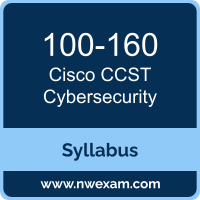 A great way to start the Cisco Certified Support Technician (CCST) Cybersecurity preparation is to begin by properly appreciating the role that syllabus and study guide play in the Cisco 100-160 certification exam. This study guide is an instrument to get you on the same page with Cisco and understand the nature of the Cisco CCST Cybersecurity exam.
A great way to start the Cisco Certified Support Technician (CCST) Cybersecurity preparation is to begin by properly appreciating the role that syllabus and study guide play in the Cisco 100-160 certification exam. This study guide is an instrument to get you on the same page with Cisco and understand the nature of the Cisco CCST Cybersecurity exam.
Our team of experts has composed this Cisco 100-160 exam preparation guide to provide the overview about Cisco Certified Support Technician (CCST) Cybersecurity exam, study material, sample questions, practice exam and ways to interpret the exam objectives to help you assess your readiness for the Cisco CCST Cybersecurity exam by identifying prerequisite areas of knowledge. We recommend you to refer the simulation questions and practice test listed in this guide to determine what type of questions will be asked and the level of difficulty that could be tested in the Cisco CCST Cybersecurity certification exam.
Cisco 100-160 Exam Overview:
|
Exam Name
|
Cisco Certified Support Technician (CCST) Cybersecurity |
| Exam Number | 100-160 CCST Cybersecurity |
| Exam Price | $125 USD |
| Duration | 50 minutes |
| Number of Questions | 40-50 |
| Passing Score | Variable (750-850 / 1000 Approx.) |
|
Recommended Training
|
Junior Cybersecurity Analyst |
| Exam Registration | PEARSON VUE |
| Sample Questions | Cisco 100-160 Sample Questions |
| Practice Exam | Cisco Certified Support Technician (CCST) Cybersecurity Practice Test |
Cisco 100-160 Exam Topics:
| Section | Objectives |
|---|---|
| Essential Security Principles |
- Define essential security principles
- Explain common threats and vulnerabilities
- Explain access management principles
- Explain encryption methods and applications
|
| Basic Network Security Concepts |
- Describe TCP/IP protocol vulnerabilities
- Explain how network addresses impact network security
- Describe network infrastructure and technologies
- Set up a secure wireless SoHo network
- Implement secure access technologies
|
| Endpoint Security Concepts |
- Describe operating system security concepts
- Demonstrate familiarity with appropriate endpoint tools that gather security assessment information
- Verify that endpoint systems meet security policies and standards
- Implement software and hardware updates
- Interpret system logs
- Demonstrate familiarity with malware removal
|
| Vulnerability Assessment and Risk Management |
- Explain vulnerability management
- Use threat intelligence techniques to identify potential network vulnerabilities
- Explain risk management
- Explain the importance of disaster recovery and business continuity planning
|
| Incident Handling |
- Monitor security events and know when escalation is required
- Explain digital forensics and attack attribution processes
- Explain the impact of compliance frameworks on incident handling
- Describe the elements of cybersecurity incident response
|
Cisco CCST Cybersecurity Exam Description:
The Cisco Certified Support Technician Cybersecurity (100-160) exam validates a candidate's skills and knowledge of entry-level cybersecurity concepts and topics, including security principles, network security and endpoint security concepts, vulnerability assessment and risk management, and incident handling.
